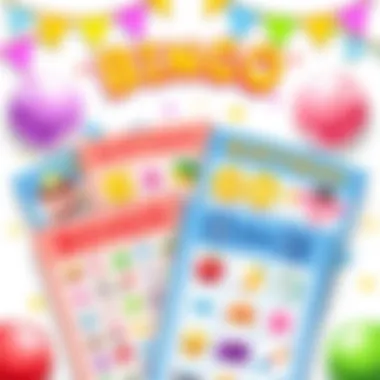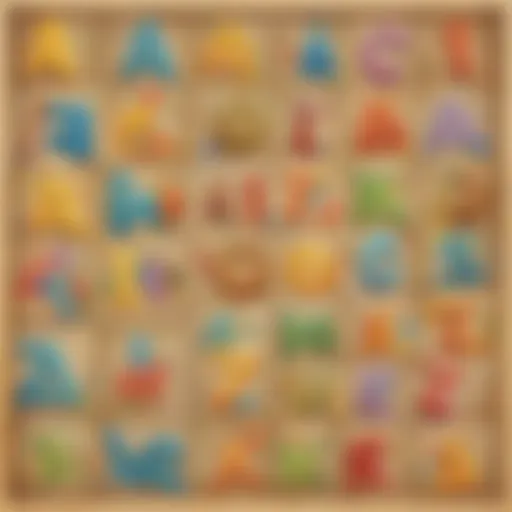Creative Bingo Birthday Party Ideas for Kids


Intro
Planning a birthday party can sometimes feel like a juggling act. For parents, it’s not just about the cake and balloons; it’s also an opportunity to ignite learning while having fun. Bingo birthday parties offer a unique blend of enjoyment and education, making them a fantastic choice that ticks all the right boxes. Imagine a room filled with laughing children, each one cheering as they complete their bingo cards, all while developing essential skills without even realizing it.
In this guide, we'll navigate through innovative bingo party ideas that resonate with children's desire to play and learn. From themes that let their imaginations soar to game variations that tap into their curiosity, every aspect is designed to create an unforgettable celebration. So, grab your markers and a notepad, and let’s dive into the vibrant world of bingo birthday parties!
Interactive Learning Games
When it comes to educational birthday parties, interactive learning games take center stage. They encourage social interaction and cognitive engagement, making them ideal for children who thrive on activity and exploration.
Popular Games
There’s a treasure trove of games that can be adapted for a bingo format. Consider these crowd-pleasers that naturally incorporate learning elements:
- Math Bingo: Perfect for reinforcing arithmetic skills. Players answer math problems to mark off their bingo cards.
- Spelling Bingo: Children can practice vocabulary while having fun. Call out definitions or scrambled letters!
- Science Bingo: Include terminology from biology, chemistry, or physics. It’s a great way to make complex topics approachable.
Description of Top Educational Games
The true beauty of these games lies in their ability to blend fun with learning. Math Bingo, for instance, not only helps kids practice addition and subtraction but also fosters teamwork as they engage with peers. Each game supports vital skills, elevating simple play to a meaningful experience.
Benefits of Playing Educational Games for Kids' Cognitive Development
Educational bingo games don’t just entertain; they contribute significantly to cognitive growth. These benefits are well noteworthy:
- Critical Thinking: Players utilize problem-solving skills to figure out answers.
- Memory Enhancement: Repeating information during gameplay can help improve retention.
- Social Skills: As they interact, children develop communication skills and build friendships.
Game Reviews
Diving deeper into specific games can help parents make informed choices. Let’s explore a few:
- Math Wiz Bingo: This game focuses on math fluency while offering different levels of difficulty. Great for mixed-age groups!
- ABC Bingo: Ideal for younger kids, this game covers basic literacy in a playful way.
Comparison of Gameplay and Learning Outcomes
Each game offers different appeals and educational outcomes. Math Wiz Bingo is particularly engaging for older kids, helping them build confidence in math. ABC Bingo, however, is suited for preschoolers, laying the groundwork for future learning. Both strategies underscore how tailored gameplay can emphasize individual growth.
Educational Topics
To add another dimension to the bingo party experience, consider incorporating various educational themes. Children can explore different subjects while playing and discovering new interests.
Compilation of Articles Covering Various Subjects
Utilizing resources such as Britannica or Wikipedia allows parents and educators to access comprehensive articles on themes ranging from history to science. This can help guide the choice of topics for bingo cards.
Importance of Interdisciplinary Learning for Holistic Development
Interdisciplinary learning offers children a contextual understanding of how knowledge connects across subjects. Integrating this concept into bingo can foster a more profound appreciation for learning itself.
Tips and Tricks
To ensure the party is both enjoyable and educational, consider these strategies:
- Make It Thematic: Station your bingo games around a central theme, like ocean exploration or space travel.
- Use Prizes Wisely: Awards don’t always have to be physical. Consider giving stickers or certificates that celebrate learning milestones.
Creative DIY Projects
For an added personal touch, consider including DIY projects that allow children to engage their hands and creativity.
Step-by-Step Guides
Engaging in DIY projects promotes creativity and problem-solving skills. Here’s a quick guide on how to make your own bingo cards:
- Gather Supplies: Cardstock, markers, and a template.
- Design Cards: Let the kids help design their bingo cards themed around their favorite subjects.
- Game Time: Use the created cards for gameplay during the party.
Craft Ideas
Simple crafts using household items can enhance the party atmosphere. Projects such as creating bingo markers from dried beans or decorating the cards can serve as both an art activity and a functional element of the game.
Artistic expression is crucial in childhood development, stimulating creativity while sharpening motor skills. Activities blend seamlessly with party fun, resulting in a memorable experience.
Remember: The aim is to strike a balance between learning and play. By merging education with celebration, you create not just a party but a transformative experience for kids.
Foreword to Bingo Birthday Parties
Having a birthday party is often a significant milestone in a child's life. It offers them a chance to celebrate with friends and family, creating lasting memories in the process. Bingo birthday parties add a fun twist to the usual festivities, making them a great option for parents and caregivers looking to craft a unique experience. They provide not just entertainment but also a way to engage children in something that goes beyond mere play.
Incorporating bingo into a birthday celebration is not only about the game itself but also about the historical context and cultural significance it carries. As a social activity, bingo has historically brought people together, making it a fitting choice for any gathering. For instance, the origins of bingo trace back to the early 16th century in Italy, where it began as a lottery game. Today, it is a beloved pastime across the globe, often used for fundraising events or community activities. By choosing bingo as the centerpiece of a birthday celebration, you tap into a rich tradition that emphasizes camaraderie and interaction.
Moreover, birthday celebrations play a crucial role in child development. They foster social skills, cultivate a sense of belonging, and can even instill a sense of responsibility as children learn to take turns and respect rules while playing games. By thoughtfully integrating bingo into birthday parties, parents can elevate the celebration from a simple event to an enriching experience that promotes learning and cooperation.
Benefits of Bingo Birthday Parties
- Social Skills Development: Children learn how to engage with peers, practice teamwork, and develop sportsmanship.
- Enhancing Cognitive Skills: The game of bingo helps improve concentration and recognition of numbers.
- Customizable Fun: Themes can elevate the experience, making it more aligned with the child’s interests.
- Inclusivity: Bingo is easy to play and suitable for diverse age groups.
"Celebrating birthdays with engaging games like bingo can lead to memorable lessons cloaked in joy."
Ultimately, a bingo birthday party goes beyond just having fun; it weaves educational threads through celebration. And in a world where every ounce of creativity counts, bingo parties offer a remarkable way to craft joyful experiences, leaving a lasting impact on children's lives.
Choosing the Right Theme
Selecting the right theme for a bingo birthday party plays a crucial role in the overall experience for children and their caregivers. A well-chosen theme sets the atmosphere, stimulates interest, and can even enhance the educational aspect of the event. It’s like the icing on the cake; while cake is essential, icing brings joy and excitement.
Themes help to create a common ground. They form a backdrop against which games, decorations, and activities are woven together. It's vital to consider the children's preferences, age, and interests when selecting a theme. Opting for trends that resonate with them guarantees not just fun but also encourages participation. Furthermore, integrating themes with educational objectives can elevate a simple game of bingo into a multi-faceted learning experience.
Popular Children’s Themes


- Superheroes
Superhero-themed parties have become a staple in children's celebrations. They tap into the adventurous spirit that many kids possess. With characters like Spider-Man or Wonder Woman, children engage not just in play but also embody values like bravery and teamwork. Creating bingo cards featuring various superhero symbols allows kids to learn recognition skills while having fun. However, the challenge can arise when selecting appropriate superheroes that all the children might enjoy. Some might be fans of lesser-known characters, while others lean toward mainstream heroes. - Princesses
A princess theme is an enduring classic that captures the imagination of many young girls and boys alike. It incorporates elements of fantasy and story-telling, creating a realm of enchantment. This theme allows for gorgeous decorations and costumes, making the bingo cards equally vibrant and whimsical. That being said, not every child enjoys the princess narrative, and in some cases, it may alienate those not interested in fairy tales. Still, the potential for creativity in design and play makes it a valuable choice for many. - Animals
The animal theme stands out as both educational and entertaining. Not only does it cater to children with a love for creatures big and small, but it also presents a chance to teach kids about various species and their habitats. Bingo cards can be tailored to include pictures or names of animals, inviting kids to learn while playing. Nonetheless, ensuring that the animal representations are sensitive and respectful of wildlife issues is critical. It's essential to strike a balance; while creating fun, it’s crucial to embed a learning experience into this theme.
Educational Themes
- Space Exploration
Space-themed parties can ignite curiosity, as children often find the universe fascinating. With topics such as planets, astronauts, and stars, the bingo game can help children develop interest in science and astronomy. Using colorful images of planets for bingo cards captures attention while promoting knowledge about our solar system. However, the complexity of concepts related to space may need simplification to aid understanding. At times, it can be quite overwhelming for younger kids who may not grasp the subject fully. - Ocean Life
An ocean life theme offers an exciting glimpse under the sea, showcasing a variety of aquatic animals and ecosystems. Kids adore marine life, and therefore integrating ocean characters into bingo can make for a fun learning platform. It’s particularly beneficial for conveying principles of conservation and aquatic education. Yet, similar to the animal theme, care must be taken to ensure that representations do not promote misconceptions about sea creatures. Navigating this can be tricky but rewarding when done correctly. - History Adventures
A history adventures theme allows children to explore different time periods, cultures, or historical figures. Using bingo to highlight important events or inventors can pique the interest of kids in history. By aligning this with fun activities and games, children can absorb knowledge without feeling like they're in a classroom setting. However, topics of history can sometimes be dry or irrelevant to young minds. Thus, careful selection of subject matters is key to harnessing engagement.
Game Variations for Different Age Groups
When it comes to hosting a bingo birthday party, tailoring the game experience to the specific age group of the children involved is of paramount importance. Younger children thrive on simplicity and vibrant visuals, while older kids often appreciate more complexity and challenge. Striking the right balance not only keeps the games engaging but also enhances their development through play.
Bingo for Younger Kids
For younger kids, the atmosphere should be filled with laughter and excitement. The bingo game can be designed with large pictures rather than numbers or letters. Consider using themes that resonate with little ones, like animals or their favorite cartoon characters. For instance, a bingo card filled with colorful images of dinosaurs, teddy bears, or princesses can really capture their interest. This visual aspect makes it easy for them to identify the items quickly, boosting their enthusiasm.
Incorporate interactive elements, like stickers as markers, which can help the kids stay engaged. Making use of cheerful tunes in the background can maintain a lively mood while they play. Additionally, the games could be relatively short to cater to younger children's shorter attention spans. Having a few rounds, where they get to shout “Bingo!” and claim a small prize, will undoubtedly add to the thrill.
Tip: Always adapt the game rules to keep it simple, such as allowing them to mark a square if their favorite animal is called out.
Bingo for Older Kids
As children grow, their cognitive skills develop, allowing for a more advanced gameplay experience. For older kids, bingo can transcend a mere number-calling game. Introducing themes that challenge their knowledge, such as science or geography, can blend education with fun. For example, a science-themed bingo could feature terms like "photosynthesis" or "volcano". Not only does this put their learning to the test, but it also encourages discussions around those themes.
The bingo cards can include various formats, such as free spaces or multi-word combinations, to increase complexity. The game can also incorporate timers, rewarding quicker responses, or even require the kids to use other sources, like trivia questions, to earn their square.
Consider presenting opportunities for larger prizes or team-based bingo, which fosters a sense of collaboration and healthy competition. Rounding off the bingo game with discussions or explanations about the topics covered reinforces their learning and paves the way for a more enriching experience.
Engaging older kids in themed bingo not only promotes fun but also supports educational development in a playful context.
In essence, whether it’s decorating bingo cards with vibrant images for the little ones or challenging the older crowd with thematic content and complex rules, game variations tailored to age groups significantly add to the excitement of the birthday celebration while enriching their learning experience.
Crafting Custom Bingo Cards
Creating custom bingo cards can elevate the excitement of a birthday party. These cards are not just pieces of paper; they represent a chance to personalize the experience for each child attending. Parents and educators can incorporate specific themes, interests, or even educational materials relevant to the group. When children see their own favorite characters or subjects on the bingo cards, it immediately captures their attention and enthusiasm, making the game more engaging.
Benefits of Custom Bingo Cards
Custom bingo cards allow for flexibility in the game. They can be tailored to suit varied age groups, ensuring that everyone feels included. Card designs can cater to the cognitive levels of participants. For younger children, simple images work wonders. For older ones, integrating words or concepts enhances the learning experience while playing.
Furthermore, custom cards can reflect the party's theme, whether it's superheroes or ocean creatures. This integration reinforces the theme and brings the entire event together cohesively. For instance, using colors and pictures that align with a 'dinosaur adventure' theme can make kids feel fully immersed in the day's fun.
DIY Printable Bingo Cards
Making DIY printable bingo cards is a straightforward process that requires minimal resources, increasing accessibility for parents and teachers. Numerous websites offer free templates that can be customized easily. Here's a basic outline to create impactful DIY bingo cards:
- Select a Template: Browse through various online resources that provide bingo card templates. Websites like Canva or Printable Bingo Cards offer easy-to-use designs.
- Customize the Content: Depending on the theme chosen, replace generic items with themed images or terms. If it's a space theme, cards can feature planets, rockets, and astronauts.
- Print and Cut: Use quality paper for printing. Consider cardstock for a more durable card; this will maintain the integrity of the cards throughout the party.
- Decorate: For a personal touch, let children color or decorate their cards before the game starts. This not only enhances their involvement but also taps into their creativity.
By printing these cards at home, you save time and money while ensuring that the game is tailored to the unique interests of the participants.
Using Themes to Inspire Designs
When crafting bingo cards, themes act as the backbone. A well-chosen theme can guide the design, making the game relevant and exciting. Think about what captivates the birthday child's imagination.
For instance, planning a princess-themed party? The bingo cards could feature castles, magic wands, and fairy tale creatures. This approach can make children feel like they are really part of the story, adding layers to the fun. Some examples of popular themes include:
- Superheroes: Use symbols or characters reflecting strength and bravery.
- Dinosaurs: Focus on various species, habitats, and even Jurassic landmarks.
- Underwater Adventure: Cards could illustrate fish, seaweed, and treasure chests.
Utilizing themes also provides an educational element. For example, during a space-themed party, children can learn about different planets while playing bingo. Each space-themed card can correspond with fun facts about the featured objects. This method fosters learning in a playful setting and maintains engagement all throughout.
"The benefits of custom bingo cards aren’t just about fun; they reinforce themes and incorporate learning in child-friendly ways."
In summary, integrating themes into card designs is an approach that aligns the games with the children's interests while ensuring the activities are educational as well. This level of customization can make all the difference in the experience of the party.
Incorporating Educational Content
Incorporating educational content into a bingo birthday party not only provides an entertaining experience for children but also enriches their learning journey. Using a game like bingo can seamlessly integrate various subjects into a playful and engaging format, making education fun and memorable. This method transforms the traditional concept of a birthday celebration by nurturing curiosity and reinforcing knowledge through interactive gameplay.
Integrating Learning Objectives
When organizing a bingo party with an educational twist, it’s crucial to define clear learning objectives. For instance, a party themed around numbers can enhance basic arithmetic skills. Bingo cards can be specifically designed to include math problems instead of traditional numbers. Imagine a card that has simple addition equations, such as "2 + 3" or "5 - 2". As children play, they must solve these equations before they can mark off their squares. This encourages cognitive skills and reinforces learning in a direct, hands-on manner.
To align with curriculum standards, select objectives that align with what the children are currently learning in school. Are they studying animals? Include a mix of biology and fun facts in the bingo cards. You can even create separate cards for different age or grade levels – ensuring that every participant feels engaged and challenged.
Using Bingo to Reinforce Concepts
Bingo can also serve as a powerful tool for reinforcing concepts across various subjects. For instance, during a themed bingo game about geography, you can incorporate states, capitals, or even landmarks into your cards. As children call out their squares, they’ll simultaneously learn about the world around them. This method engages multiple senses, as kids not only see and hear but also think critically about the information being presented.
"Learning should never be confined to the classroom walls. Incorporating playful formats like bingo can ignite a passion for knowledge."
Incorporating different categories can create a well-rounded activity that caters to various interests. For instance, you can set up a bilingual bingo where children match words in their primary language with translations. This would not only enhance vocabulary but also encourage linguistic skills. Creating a diverse bingo experience can foster inclusivity and ensure that every child leaves with something valuable in their hands.
Not only does this approach invigorate the learning process, but it also functions as a conversation starter among peers. After playing, children can discuss what they learned, share fun facts, or explain their strategies. This reflection time solidifies their understanding and allows for reinforcement of the connections made during the game.
Creating an Engaging Atmosphere
An engaging atmosphere is key to any successful bingo birthday party. The environment sets the tone for the celebration, directly influencing the kids' excitement and participation. When the visual and sensory aspects are in sync with the theme, kids are more likely to get into the spirit of the game. An immersive setting not only captures attention but also enhances the overall experience, making it memorable.
Decorations that Enhance the Theme
Decorations are more than just eye candy; they're the first thing guests notice and can spark interest right from the get-go. Depending on the chosen theme, the decorations can vary widely. If the theme is space, think about black and silver balloons, star cutouts on the walls, and tablecloths that mimic the galaxy. For a princess-themed party, glittery drapes, crowns, and beautiful floral arrangements can create a magical ambiance.
Here are some ideas to effectively enhance your theme through decorations:
- Banners and Signs: Make welcome signs that tie into the theme. A “Welcome to the Jungle” banner for an animal theme will excite the little explorers.
- Table Settings: Use themed plates, napkins, and cups that complement the decorations. For instance, checkered patterns for a racing theme or ocean-printed items for an underwater adventure.
- Activity Stations: Designate areas for specific activities. For example, a craft table decorated to match the party's theme can entice kids to get creative.
These elements not only beautify the space but also offer talking points that can excite and engage kids as they arrive, ensuring they are instantly captivated by their surroundings.
Lighting and Ambiance Considerations


Lighting makes a profound difference in creating a successful atmosphere, which can lead to a more enjoyable experience. Bright lighting can invigorate a room, while softer lights can create a more relaxed and enchanting setting.
Here are some tips to consider when planning the lighting for the party:
- Natural Light: If your event is during the day, use natural light to your advantage. Open curtains to let sunlight in, creating a cheerful environment.
- String Lights: For evening celebrations, string lights can add a whimsical touch. They can be draped along walls or hung above the party area to create a starry effect.
- Colorful Bulbs: Utilizing colored bulbs can also help align the atmosphere with the theme. For example, blue and green lights can enhance an ocean theme, while bright yellows and pinks evoke a playful setting.
"Light is to the party as icing is to the cake—essential for creating the right balance of fun and excitement!"
Ultimately, thoughtfulness in decoration and lighting ties the whole event together, cultivating a lively atmosphere and encouraging even the shyest of children to dive into the festivities. They contribute significantly to making bingo more interactive, engaging, and enjoyable for the kids.
Food and Snack Ideas
Food plays a crucial role in any birthday celebration, and a bingo-themed party is no exception. Snacks and meals not only fill hungry bellies but also contribute significantly to the overall atmosphere. When it comes to kids, thoughtfulness in food selection goes a long way—it can foster engagement and enhance their enjoyment of the games.
Moreover, providing well-thought-out snack options can encourage social interactions among children. Think about crafting a menu that aligns with the theme of the party while offering flavors and textures that cater to both picky eaters and adventurous palettes.
Themed Snacks that Align with the Party
Creating snacks that mirror the bingo theme can be both fun and memorable. For instance, if the bingo is centered around a space exploration theme, consider star-shaped sandwiches or rockets made from fruit skewers. Using cookie cutters, you can easily make shapes that resonate with the party theme, like crown-shaped peanut butter and jelly sandwiches for a princess theme. Here are a few ideas:
- Bingo Potatoes: Use small baked potatoes decorated with crafty toppings like cheese, sour cream, and chives. You could even stick a toothpick with a number on top of each for that bingo vibe!
- Bingo Bingo Cups: Fill red Solo cups with snacks but write their names on the outside as if they were bingo cards, turning munching into a guessing game.
- Lucky Numbers Fruit Platter: Arrange an array of colorful fruits into the shape of a bingo card, letting kids pick their "lucky numbers" of fruits to enjoy.
These creative snacks elevate the experience, encouraging the little ones to try everything by tying flavors to themes they love.
Healthy Options for Kids
While delightful treats keep the excitement alive, it’s also important to consider healthier choices that can fuel energetic play without a sugar crash later on. Dishing out nutritious and fun snacks can be a tricky balancing act, but it’s essential for the well-being of the children attending.
Here’s how to seamlessly blend health with fun:
- Veggie Cups: Individual cups of carrot and celery sticks, cherry tomatoes, and hummus can provide a crunchy alternative to chips. Kids enjoy the hands-on experience, and this option helps increase their vegetable intake.
- Fruit Kabobs: Skewering chunks of fruit like melon, grapes, and pineapple not only makes it visually appealing but also encourages kids to pick at healthy foods throughout the festivities.
- Yogurt Parfaits: Layer yogurt with granola and berries in cups for a sweet yet nutritious option. Kids love to see their creations and can personalize each parfait with toppings.
Balancing the menu is key—it’s not just about keeping kids happy but ensuring they’re fueled for fun during the games. The right snacks can support their energy levels and keep their spirits high from start to finish.
Providing a vivid food experience at a bingo birthday party enhances engagement and creates a comprehensive atmosphere. Snacks embody the theme and can act as catalysts for social interaction among children, ensuring everyone has a splendid time.
Overall, the food and snack ideas should ideally reflect creativity, nutritional value, and align to the festive vibe of the bingo birthday party, making it a day to remember.
Planning the Event Timeline
Creating a successful Bingo birthday party isn't just about having the right games and snacks. A well-planned event timeline can truly enhance the experience and ensure every guest is engaged from start to finish. Proper timing plays a significant role in keeping the energy high and the mood festive. This section offers insights into structuring your event in a way that maximizes enjoyment while allowing for the smooth flow of activities.
Structuring the Agenda
When it comes to structuring the agenda, think of it as mapping out a journey. Your guests are not just attendees; they are participants on a mini-adventure. An effective timeline is the road that guides them along this adventure, ensuring everyone knows what’s coming next.
Start with a warm welcome as guests arrive. This is the moment to let everyone settle in and get acquainted. Consider allowing 10-15 minutes for guests to mingle. A little chatter and laughter during the initial arrival can set a welcoming tone.
After welcoming, it’s time for the main event—Bingo! Having a designated Bingo game session that lasts around 30-40 minutes gives ample time for rounds while preventing players from losing focus. Make sure you provide clear instructions and maybe run a quick practice round for younger kids who may be unfamiliar with the game.
Once the Bingo games are done, it’s a good practice to include 10 minutes for a break. Not only does this provide kids a chance to stretch their legs, but it also allows for pops of energy to be refueled. Provide light refreshments like fruit slices or popcorn during this intermission.
Consider adding moments that break up your timeline into digestible pieces instead of a continuous block of activities. For example, after a snack break, jump into a few different party activities like crafts, storytelling, or simple games to further keep the kids engaged. Keep in mind that children thrive on variety, and switching things up can keep their interest piqued.
Finally, don’t forget a wrap-up session. After all the fun, gather everyone for a recap of the day, perhaps announcing winners of the Bingo games or taking a moment to say thank you. This not only gives a sense of closure but leaves kids feeling celebrated and appreciated.
Incorporating Breaks and Activities
As the old saying goes, "All work and no play makes Jack a dull boy." Similarly, if you cram activities too closely together without incorporating breaks, you’ll likely find your young guests becoming restless or bored. Breaks and activities are essential for maintaining excitement and engagement.
During each break, consider introducing fun and simple activities that don’t require extensive setup. For instance:
- Dance-offs to pump up the energy, letting kids show off their best moves.
- Quick art stations where kids can doodle or color templates related to your Bingo theme.
- Group games like 'Simon Says' or 'Duck Duck Goose' to keep the atmosphere lively.
- Storytelling sessions to engage their minds and enhance creativity if there's enough time or space.
Such activities serve two main purposes: they give children a chance to recharge mentally while maintaining the festive spirit of the gathering.
In summary, planning a thoughtful event timeline not only helps in organizing the party seamlessly but also enriches the overall experience for children. Consider how an effective balance of activities and breaks can contribute to fascination and excitement during your Bingo birthday party. Want to learn more about time management in events? Check out additional resources on Event Management Basics.
Remember, a well-structured party timeline means more smiles and happy memories for everyone!
Prizes and Rewards
In any birthday party setting, the notion of prizes and rewards is pivotal, especially in an activity like Bingo that inherently involves competition and excitement. A well-thought-out prize system can elevate the experience, ensuring that each participant feels valued and motivated to engage fully in the festivities. After all, what’s a game without a little something to strive for? Not only do prizes amplify the fun, but they also foster a sense of accomplishment among the players. This is particularly important in a learning environment where encouragement can significantly impact children's enthusiasm to learn and play.
Prizes can range from tangible items, like toys or treats, to experiences that stick in the memory. Understanding the significance of this aspect can help you create a lively and enriching environment where every child walks away with not only fun memories but also a tangible token of their hard work.
Selecting Appropriate Prizes
Choosing the right prizes requires a touch of thought and foresight. You want to avoid the trap of selecting items simply based on what’s trending; instead, focus on what will resonate most with the children attending. Consider these factors:
- Age Appropriateness: Prizes should align with the developmental stage of the children. For younger kids, small toys, stickers, or coloring books are great. Older kids might appreciate items like craft kits, puzzles, or even gift cards to their favorite stores.
- Preference of Participants: If you know the interests of your guest list, tailor your prize selection. This could mean getting action figures for a superhero-themed party or art supplies for a creative crowd.
- Quality Over Quantity: A few well-chosen, high-quality prizes will leave a more lasting impression than a mountain of cheap trinkets. This can nurture a culture where children appreciate what they earn.
Furthermore, consider incorporating a “grand prize” for the overall winner. This could be something like a larger toy or experience vouchers, which can stir up more competition and excitement among participants.
Balancing Fun and Educational Value
A successful Bingo birthday party doesn’t just focus on fun; it can foster educational growth as well. Therefore, it’s essential to strike a balance between fun and educational value when selecting prizes. Here’s how you can approach this:
- Learning Tools: Prizes can be tools that promote further learning. For example, consider STEM kits or educational board games that derive enjoyment from educational concepts. These prizes become not only rewards but also incentives to continue learning.
- Inclusive Themes: Each prize could also relate to the theme of the party. If the theme is education-based, prizes could include books or science kits that align directly with interests they were engaging with during the party. This gives kids a sense of continuity from the game to real-life skills.
- Encourage Creativity: Provide craft-related items as prizes. For instance, art supplies can spur creativity and leave children enthused to try their hands at something new.
In this way, prizes serve a dual purpose—recognizing achievement while also promoting continued learning and creativity beyond the event.
Selecting the right prizes can turn a good party into a memorable experience that encourages exploration and growth.
Engaging with Parents and Caregivers


Involving parents and caregivers in the planning and execution of a bingo birthday party is not just beneficial; it is essential. These individuals play a crucial role in ensuring that the environment is not only fun but also supportive and educational. When parents are engaged, the celebration takes on a collective spirit that fosters a sense of community while enhancing the overall experience for the children involved. This collaboration can lead to increased enthusiasm and participation, making the event one to remember.
Encouraging Participation
Engaging parents and caregivers starts with encouraging their active participation. Providing interactive roles—like co-hosting games or organizing snack preparation—can be beneficial. When parents take on these responsibilities, it fosters teamwork and allows them to bond. Here are ideas that can inspire participation:
- Game Facilitators: Assign parents to oversee different game stations, ensuring that everything runs smoothly. This gives them a chance to mingle, support their kids, and contribute to the fun.
- Craft Coordinators: If the theme includes crafts or activities, let parents lead these stations. Sharing ideas and creativity can form connections that extend beyond the party itself.
- Refreshment Helpers: Offering snacks can sometimes be overwhelming. Parents can sign up to bring themed treats, keeping the baked goods fresh and aligning with the party's theme, whether it be ocean life cupcakes or superhero cookies.
Encouraging this level of involvement creates a sense of ownership and pride among parents. They not only feel appreciated but also become part of the joyous fabric of the celebration.
Creating a Supportive Environment
A supportive environment is key. A critical component of parenting is forging connections between children and their caregivers. When organizing a bingo birthday party, ensuring that parents feel involved and supported can significantly enhance this engagement. Consider these factors:
- Open Communication: Foster a culture where parents can express their ideas, concerns, or preferences. A group chat or a planning meeting can be a great start, allowing for collective input and brainstorming.
- Welcome Feedback: After the event, gathering feedback from parents is equally important. It helps to understand what they enjoyed or suggestions for future events. This can lead to improved experiences and future participation.
- Inclusion of Diverse Needs: Every child is unique and may come to the party with different requirements or comfort zones. Communicating openly about these can ease any anxieties and cultivate a welcoming atmosphere for all children and parents.
"Creating a welcoming environment not only enhances the children's enjoyment but also strengthens community ties.”
Maintaining a supportive atmosphere allows both children and parents to thrive. Creating special moments at a bingo birthday party requires collaboration and understanding, proving that engaging with parents and caregivers holds immense value not just for this occasion but for all future gatherings.
Feedback and Reflection
When planning a bingo birthday party, one often overlooks the pivotal role that feedback and reflection play in creating enriching experiences for children. By emphasizing these elements, this guide aspires not only to produce joyful celebrations but to cultivate learning opportunities that resonate long after the party has ended. Gathering insights from participants can unveil valuable perspectives, providing parents and caregivers with a clearer picture of what truly resonates with the kids. Equally vital is the application of this feedback in future events, refining the approach to ensure that each celebration becomes even more engaging and tailored to the children’s needs.
Gathering Insights from Participants
As soon as the last bingo card is put down, it's tempting to declare the party a success and move on. However, taking a moment to gather insights from participants can be an illuminating exercise. This doesn’t necessarily mean conducting formal interviews; informal chats during the event or quick follow-up messages can yield rich information.
Ask questions like:
- What did you enjoy most about the games?
- Were there any parts that felt too long or confusing?
- Did the prizes reflect what you expected?
These inquiries not only show attentiveness but also foster a sense of involvement and investment among participants. Children’s opinions may surprise you—what delights one child might not have the same effect on another.
Offering a few simple ways to provide feedback, such as rating sheets or fun emoji stickers, can encourage kids to express their thoughts frankly. You'll likely find that they remember the themes and activities more than you might expect, providing you with tangible insights into their preferences.
Using Feedback for Future Events
Once you've gathered the essential feedback, the next step is its application. Utilizing insights from participants can significantly enhance the planning process for future bingo parties. Consider their suggestions when deciding on new themes, game variations, or even food options. For instance, if you notice many kids enjoyed the educational elements, think about including more of them next time.
Moreover, a reflective approach means revisiting the party structure. If parents mentioned that certain activities led to overwhelmed kids, adjusting the event schedule can make a world of difference. You could add downtime or alternative activities to give everyone a breather.
Ultimately, using feedback fosters a cycle of continuous improvement. Each event becomes a stepping stone toward greater understanding of what works best. Whether it’s enriching children's learning or simply crafting a joyful celebration, integrating these insights allows for personalized touches that resonate well with both children and their families.
"Feedback isn’t just about numbers; it’s about understanding the heart of the experience."
Safety Considerations
When planning a bingo birthday party, ensuring safety is paramount. Kids may be all about fun and games, but a careless oversight can lead to mishaps that put a damper on the festivities. By being proactive about safety measures, you not only protect the well-being of the little ones but also create an environment where both parents and children can let loose and enjoy themselves. Let’s dive into some key aspects to consider.
Creating a Safe Playing Environment
A safe playing environment is the backbone of any successful birthday bash. First things first, think about the space you're using. Whether it’s a backyard or a community center, keep an eye out for potential hazards. Here are a few pointers:
- Clear Out Clutter: Remove any loose objects, sharp edges, or anything that could cause tripping. Kids are masters at running around, and you want to keep them from tumbling over stray items.
- Designated Game Areas: Set specific spots for bingo games. It keeps the chaos somewhat controlled and helps parents keep an eye on the kiddos. Moreover, it’s good to create boundaries, so no one strays too far from the group.
- Supervision is Key: Having enough adults on hand to supervise is crucial. This isn’t just about keeping the peace; it's about ensuring that there’s always a set of eyes on the younger ones. Consider assigning a volunteer or two to oversee the various activities.
Implementing these simple safety measures goes a long way in preventing mishaps and ensuring that the games can go on uninterrupted.
Ensuring Food Safety
Food is texture to the heart, especially at birthday parties. But when it comes to snacks and treats, safety should be on the guest list, too. Keeping food safety in mind prevents any unfortunate upsets that could spoil the day. A few safety measures to consider:
- Allergenic Ingredients: Always check for foods that could trigger allergies. If you plan to serve snacks, ask parents ahead of time about common allergens. Peanut butter and gluten are often culprits, so be smart about your menu choices.
- Temperature Control: Keep hot foods hot and cold foods cold. Warm snacks should remain above 140 degrees Fahrenheit, while cold treats must stay below 40 degrees Fahrenheit. Food safety isn't just a guideline; it's a necessity.
- Sanitation Practices: Ensure that any food prep areas are clean. Wash hands before handling food, and don’t forget about utensils. A clean environment minimizes the risk of bacteria mingling with the snacks.
Following these food safety tips helps ensure that everyone can enjoy the delights of the party without worrying about what might come later. After all, a birthday should be about making happy memories, not regretting what was eaten.
"A thorough focus on safety can turn a basic gathering into a truly remarkable event, setting a positive tone for everyone involved."
By keeping safety a top priority in both the playing environment and food preparation, hosts can focus more on the fun aspects of the bingo birthday party and create a joyous atmosphere for all involved.
Potential Challenges
When planning a bingo birthday party, it's crucial to anticipate and address potential challenges that may arise. Successfully managing these hurdles not only enhances the experience but also ensures that both children and adults enjoy the festivities to the fullest. When you think about it, overcoming these obstacles is part and parcel of creating a memorable day.
Managing Diverse Age Groups
Bingo is not just a game; it’s a platform that can engage kids of various ages. However, with age diversity comes the challenge of catering to different developmental stages and interests. For example, what excites a five-year-old might not hold the same allure for a ten-year-old. Here are some key considerations:
- Game Complexity: The rules need to be straightforward enough for younger players while still engaging for the older ones. You might want to create different bingo cards or modify the rules slightly for different age brackets.
- Learning Objectives: Integrating educational content can be a double-edged sword. You may want a fun bingo game for younger kids but add a trivia aspect for older ones. This keeps everyone engaged but can require balancing effort and focus among age groups.
- Timing of Activities: Keep younger kids focused by breaking activities into short, manageable chunks. If older kids are bored, they may lose interest altogether, so it’s wise to include them in decision-making on games and themes.
Handling Unexpected Situations
Every parent knows that not everything goes according to plan. The best-laid party arrangements can be disrupted by unforeseen circumstances, and bingo birthday parties are no exception. Here are some ideas on how to handle potential surprises:
- Weather Issues: If you’re planning an outdoor event, have a backup location in mind. A quick call to a nearby community center or using your living room could save the day.
- Equipment Failures: Technology can be finicky. Should your digital bingo system fail, don’t fret! You can always resort to traditional paper cards and markers. Additionally, having some fun alternatives or fallback games in mind could keep spirits high.
- Behavioral Concerns: With kids, you never know what might happen. If tempers flare or a child feels overwhelmed, have a quiet corner set aside. It can help young ones gather themselves without feeling sidelined.
In the grander scheme, being prepared for these potential challenges can transform what might’ve been stumbling blocks into stepping stones, allowing your bingo birthday party to run smoothly and be a hit for everyone involved.
Ending
The significance of hosting a bingo birthday party extends beyond mere entertainment; it embodies a blend of celebration, education, and creativity. This article aims to shine a light on how bingo can transform a simple birthday gathering into an engaging experience that not only delights children but also fosters an environment rich in learning. Planning a bingo-themed event allows parents, teachers, and caregivers to create lasting memories while also nurturing essential skills such as pattern recognition, social interaction, and even emotional regulation.
The Lasting Impact of Bingo Birthdays
Bingo birthdays hold an intrinsic value that resonates well beyond the day itself. When engaging in bingo games, children often find themselves not just filled with excitement but also immersed in a world where social skills are enhanced. They learn to take turns, celebrate wins graciously, and cope with disappointments—fundamentals that will aid them throughout their lives.
Moreover, the themes explored during these parties can ignite imagination. For example, a space-themed bingo party can instill a fascination for the cosmos, making children curious about planets and stars. This blend of learning and fun leads to an enduring interest in various subjects. Essentially, the memories carved during such events resonate like echoes in a canyon, long after the last piece of cake is consumed.
Encouraging Creativity and Learning
Integrating educational components into a bingo birthday party fosters a unique learning atmosphere. Blitzing traditional concepts like colors and numbers with vibrant designs or even fantastic narratives infuses creativity into the games. For instance, customized bingo cards that feature shapes, animals, or historical figures can seamlessly mesh learning with play. As children mark off squares, they unknowingly reinforce their knowledge of the subject at hand.
Crafts tied to the bingo theme can further enhance creativity. Kids could design their own bingo cards or even decorate the playing space with hand-drawn art related to the chosen theme. This not only keeps them engaged but also allows for imaginative expression. In a nutshell, using bingo as a foundation can cultivate an environment where creativity profits and curiosity flourishes.
Ultimately, the bingo birthday event can be a treasure trove of momentous experiences, serving as much more than mere entertainment. Through thoughtful planning, it becomes a powerful tool to shape young minds and build meaningful relationships, ensuring that celebrations are not just about cake and balloons, but about growth and togetherness. The echoes of laughter, learning, and camaraderie will linger in the hearts of all participants well beyond the closing thoughts of a day well spent.















